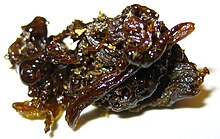
Back Hašišový olej Czech Haschischöl German Χασισέλαιο Greek Aceite de hachís Spanish Hašišiõli Estonian روغن حشیش Persian Huile de haschich French हशीश तेल Hindi Hašišovo ulje Croatian Olio di hashish Italian
| Hash oil | |
|---|---|
 One form of hash oil | |
| Source plant(s) | Cannabis sativa, Cannabis indica, Cannabis ruderalis (rarely) |
| Part(s) of plant | all parts (excluding roots and seeds) |
| Geographic origin | United States Afghanistan |
| Active ingredients | Tetrahydrocannabinol, cannabidiol, cannabinol, tetrahydrocannabivarin |
| Legal status |
|
| Part of a series on |
| Cannabis |
|---|
 |
Hash oil or cannabis oil is an oleoresin obtained by the extraction of cannabis or hashish.[1] It is a cannabis concentrate containing many of its resins and terpenes – in particular, tetrahydrocannabinol (THC), cannabidiol (CBD), and other cannabinoids. Hash oil is usually consumed by smoking, vaporizing or eating.[2] Preparations of hash oil may be solid or semi-liquid colloids depending on both production method and temperature and are usually identified by their appearance or characteristics. Color most commonly ranges from transparent golden or light brown, to tan or black. There are various extraction methods, most involving a solvent, such as butane or ethanol.[2]
Hash oil is an extracted cannabis product that may use any part of the plant, with minimal or no residual solvent. It is generally thought to be indistinct from traditional hashish, at-least according to the 1961 UN Single Convention on Narcotic Drugs that defines these products as "the separated resin, whether crude or purified, obtained from the cannabis plant".
Hash oil may be sold in cartridges used with pen vaporizers. Cannabis retailers in California have reported about 40% of their sales are from smokeable cannabis oils.[3]
- ^ Jaipakdee, Napaphak; Tabboon, Peera; Limpongsa, Ekapol (25 January 2022). "Application of a liquisolid technique to cannabis sativa extract compacts: Effect of liquid vehicles on the dissolution enhancement and stability of cannabinoids". International Journal of Pharmaceutics. 612: 121277. doi:10.1016/j.ijpharm.2021.121277. ISSN 0378-5173. PMID 34774694. S2CID 244004489.
- ^ a b Al-Zouabi, Ihsan; Stogner, John M.; Miller, Bryan Lee; Lane, Elizabeth S. (2 November 2018). "Butane hash oil and dabbing: insights into use, amateur production techniques, and potential harm mitigation". Substance Abuse and Rehabilitation. 9: 91–101. doi:10.2147/SAR.S135252. PMC 6220730. PMID 30464676.
- ^ Lewis, Amanda Chicago (30 April 2015). "Wax Is Weed's Next Big Thing And No One Knows If It's Safe". Buzzfeed. Retrieved 3 June 2018.